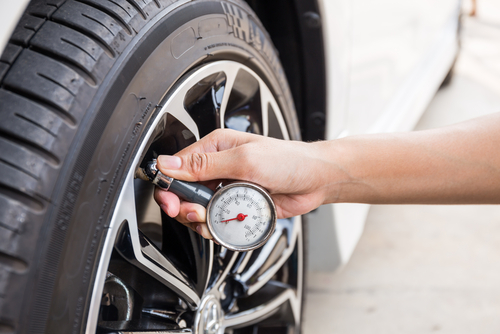
Most of us take tires for granted. They’re not nearly as interesting as comfortable seats, advanced technology, or great speakers. However, tires are one of your vehicle’s most important components. And as obvious as that sounds, many drivers unknowingly neglect this critical part of maintenance. Best of all, taking care of your tires can save cash each time you fill your tank. Definitely worth paying attention to, right?
Fuel Economy
Gas mileage can be improved by up to 3.3% by keeping your tires inflated to the proper pressure. On the other hand, under-inflated tires can lower gas mileage by 0.3% for every 1 psi drop in pressure on all four tires. That may seem like a small amount, but over time it’s sure to add up. The proper tire pressure for your vehicle is often found on a sticker in the driver’s side door jamb or the glove compartment, as well as in your owner’s manual. By taking a few minutes to learn about the proper tire pressure for your vehicle, you can make big improvements in fuel economy.
After-Market Wheels and Tires
While there are those of us who don’t give our tires more than a passing glance, others take pride in sprucing them up. After-market wheels and tires are a widely popular way to personalize a vehicle. However, there are many aspects to consider, besides which wheel and tire combo looks best. That’s because when engineering a vehicle, each manufacturer spends a great deal of time and resources to determine the ideal wheel size and tire type for every model. Often times a tire manufacturer will collaborate alongside a vehicle manufacturer to create a new tire or tread design to meet the manufacturer’s specifications for that vehicle.
In addition, the Environmental Protection Agency establishes the mile-per-gallon, city and highway numbers included on every window sticker. These numbers are based on the vehicle’s original equipment, meaning that after-market wheels and tires can affect handling and fuel economy. That’s not to say after-market tires aren’t being purchased. The Transportation Research Board reports that 200 million replacement tires are purchased each year, at the cost of $20 billion. That’s big business. However, while most drivers don’t base their decision on fuel economy, staying within the manufacturer’s specifications can improve mileage.
Plan of Action
Doing your research before replacing equipment can have a big impact on fuel economy, as can maintaining the proper tire pressure at recommended levels. The Energy Department estimates that passenger-car tires are typically 5 to 15 psi below the commonly recommended level of 30 to 35 psi. Under-inflated tires add resistance, making your engine work harder to push your vehicle along the road, and in turn burning more fuel.
It’s a smart idea to purchase an inexpensive tire gauge and keep it in your glove compartment. Once a month, check your tire pressure and add air as needed. It’s best to check pressure when the tires are relatively cold, rather than after a long drive. Another way to save on fuel economy is to slow down and focus on driving more smoothly. If you’re a driver prone to continual speeding up and slowing down, you might as well throw your hard-earned cash out the window. Driving at moderate, consistent speeds can increase fuel efficiency by as much as 33%.
By practicing a few smart maintenance and driving techniques, you can enjoy a boost in fuel efficiency and longevity of your vehicle. It’s time we stop taking our tires for granted, and pay them the proper attention they deserve. Your vehicle and your wallet will thank you, wherever the road leads.





